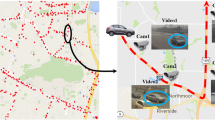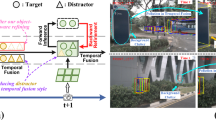Abstract
Detecting visible as well as invisible objects of interest in real-world scenes is crucial in new-generation video-surveillance. For this purpose, we design a fully intelligent system incorporating semantic, symbolic, and grounded information. In particular, we conceptualize temporal representations we use together with spatial and visual information in our multi-view tracking system. It uses them for automated reasoning and induction of knowledge about the multiple views of the studied scene, in order to automatically detect salient or hidden objects of interest. Tests on standard datasets demonstrated the efficiency and accuracy of our proposed approach.
Access this chapter
Tax calculation will be finalised at checkout
Purchases are for personal use only
Similar content being viewed by others
References
Albanese, M., Molinaro, C., Persia, F., Picariello, A., Subrahmanian, V.S.: Finding unexplained activities in video. In: Proceedings of the AAAI International Joint Conference on Artificial Intelligence, pp. 1628–1634 (2011)
Allen, J.F.: Maintaining knowledge about temporal intervals. Commun. ACM 26(11), 832–843 (1983)
Bai, L., Lao, S., Jones, G.J.F., Smeaton, A.F.: Video semantic content analysis based on ontology. In: Proceedings of the IEEE International Machine Vision and Image Processing Conference, pp. 117–124 (2007)
Berclaz, J., Fleuret, F., Tueretken, E., Fua, P.: Multiple object tracking using K-shortest paths optimization. IEEE Trans. Pattern Anal. Mach. Intell. 33(9), 1806–1819 (2011)
Bernardin, K., Stiefelhagen, R.: Evaluating multiple object tracking performance: the CLEAR MOT metrics. EURASIP J. Image Video Process. 2008, 1–10 (2008)
Bhat, M., Olszewska, J.I.: DALES: automated tool for detection, annotation, labelling and segmentation of multiple objects in multi-camera video streams. In: Proceedings of the ACL International Conference on Computational Linguistics Workshop, pp. 87–94 (2014)
Chen, L., Wei, H., Ferryman, J.: ReadingAct RGB-D action dataset and human action recognition from local features. Pattern Recogn. Lett. 50, 159–169 (2014)
Dai, X., Payandeh, S.: Geometry-based object association and consistent labeling in multi-camera surveillance. IEEE J. Emerg. Sel. Top. Circ. Syst. 3(2), 175–184 (2013)
Evans, M., Osborne, C.J., Ferryman, J.: Multicamera object detection and tracking with object size estimation. In: Proceedings of the IEEE International Conference on Advanced Video and Signal Based Surveillance, pp. 177–182 (2013)
Ferrari, V., Tuytelaars, T., Gool, L.V.: Simultaneous object recognition and segmentation from single or multiple model views. Int. J. Comput. Vis. 67(2), 159–188 (2006)
Ferryman, J., Hogg, D., Sochman, J., Behera, A., Rodriguez-Serrano, J.A., Worgan, S., Li, L., Leung, V., Evans, M., Cornic, P., Herbin, S., Schlenger, S., Dose, M.: Robust abandoned object detection integrating wide area visual surveillance and social context. Pattern Recogn. Lett. 34(7), 789–798 (2013)
Fleuret, F., Berclaz, J., Lengagne, R., Fua, P.: Multicamera people tracking with a probabilistic occupancy map. IEEE Trans. Pattern Anal. Mach. Intell. 30(2), 267–282 (2008)
Fookes, C., Denman, S., Lakemond, R., Ryan, D., Sridharan, S., Piccardi, M.: Semi-supervised intelligent surveillance system for secure environments. In: Proceedings of the IEEE International Symposium on Industrial Electronics, pp. 2815–2820 (2010)
Gomez-Romero, J., Patricio, M.A., Garcia, J., Molina, J.M.: Ontology-based context representation and reasoning for object tracking and scene interpretation in video. Expert Syst. Appl. 38(6), 7494–7510 (2011)
Jeong, J.W., Hong, H.K., Lee, D.H.: Ontology-based automatic video annotation technique in smart TV environment. IEEE Trans. Consum. Electron. 57(4), 1830–1836 (2011)
Kasturi, R., Goldgof, D., Soundararajan, P., Manohar, V., Garofolo, J., Boonstra, M., Korzhova, V., Zhang, J.: Framework for performance evaluation of face, text, and vehicle detection and tracking in video: data, metrics, and protocol. IEEE Trans. Pattern Anal. Mach. Intell. 31(2), 319–336 (2009)
Kowaslki, R., Sergot, M.: A logic-based calculus of events. New Gener. Comput. 4, 6795 (1986)
Lehmann, J., Neumann, B., Bohlken, W., Hotz, L.: A robot waiter that predicts events by high-level scene interpretation. In: Proceedings of the International Conference on Agents and Artificial Intelligence, pp. I.469–I.476 (2014)
Mavrinac, A., Chen, X.: Modeling coverage in camera networks: a survey. Int. J. Comput. Vis. 101(1), 205–226 (2013)
Natarajan, P., Nevatia, R.: EDF: a framework for semantic annotation of video. In: Proceedings of the IEEE International Conference on Computer Vision Workshops (ICCVW 2005) (2005)
Olszewska, J.I.: Multi-target parametric active contours to support ontological domain representation. In: Proceedings of the RFIA Conference, pp. 779–784 (2012)
Olszewska, J.I.: Multi-scale, multi-feature vector flow active contours for automatic multiple-face detection. In: Proceedings of the International Conference on Bio-Inspired Systems and Signal Processing (2013)
Olszewska, J.I.: Multi-camera video object recognition using active contours. In: Proceedings of the International Conference on Bio-Inspired Systems and Signal Processing, pp. 379–384 (2015)
Olszewska, J.I., McCluskey, T.L.: Ontology-coupled active contours for dynamic video scene understanding. In: Proceedings of the IEEE International Conference on Intelligent Engineering Systems, pp. 369–374 (2011)
Olszewska, J.: Tracking the invisible man - knowledge-based detection of hidden objects for complex visual scene understanding. In: Proceedings of the International Conference on Agents and Artificial Intelligence (ICAART 2016), pp. 223–229 (2016)
Park, H.-S., Cho, S.-B.: A fuzzy rule-based system with ontology for summarization of multi-camera event sequences. In: Rutkowski, L., Tadeusiewicz, R., Zadeh, L.A., Zurada, J.M. (eds.) ICAISC 2008. LNCS (LNAI), vol. 5097, pp. 850–860. Springer, Heidelberg (2008). doi:10.1007/978-3-540-69731-2_81
Remagnino, P., Shihab, A.I., Jones, G.A.: Distributed intelligence for multi-camera visual surveillance. Pattern Recogn. 37(4), 675–689 (2004)
Riboni, D., Bettini, C.: COSAR: hybrid reasoning for context-aware activity recognition. Pers. Ubiquitous Comput. 15(3), 271–289 (2011)
Ryoo, M.S., Aggarwal, J.K.: Semantic understanding of continued and recursive human activities. In: Proceedings of the IEEE International Conference on Pattern Recognition (ICPR 2006) (2006)
Sridhar, M., Cohn, A.G., Hogg, D.C.: Unsupervised learning of event classes from video. In: Proceedings of the AAAI International Conference on Artificial Intelligence, pp. 1631–1638 (2010)
Vrusias, B., Makris, D., Renno, J.P., Newbold, N., Ahmad, K., Jones, G.: A framework for ontology enriched semantic annotation of CCTV video. In: Proceedings of the IEEE International Workshop on Image Analysis for Multimedia Interactive Services, p. 5 (2007)
Yilmaz, A., Javed, O., Shah, M.: Object tracking: a survey. ACM Comput. Surv. 38(4), 13 (2006)
Author information
Authors and Affiliations
Corresponding author
Editor information
Editors and Affiliations
Rights and permissions
Copyright information
© 2017 Springer International Publishing AG
About this paper
Cite this paper
Olszewska, J.I. (2017). Detecting Hidden Objects Using Efficient Spatio-Temporal Knowledge Representation. In: van den Herik, J., Filipe, J. (eds) Agents and Artificial Intelligence. ICAART 2016. Lecture Notes in Computer Science(), vol 10162. Springer, Cham. https://doi.org/10.1007/978-3-319-53354-4_17
Download citation
DOI: https://doi.org/10.1007/978-3-319-53354-4_17
Published:
Publisher Name: Springer, Cham
Print ISBN: 978-3-319-53353-7
Online ISBN: 978-3-319-53354-4
eBook Packages: Computer ScienceComputer Science (R0)




